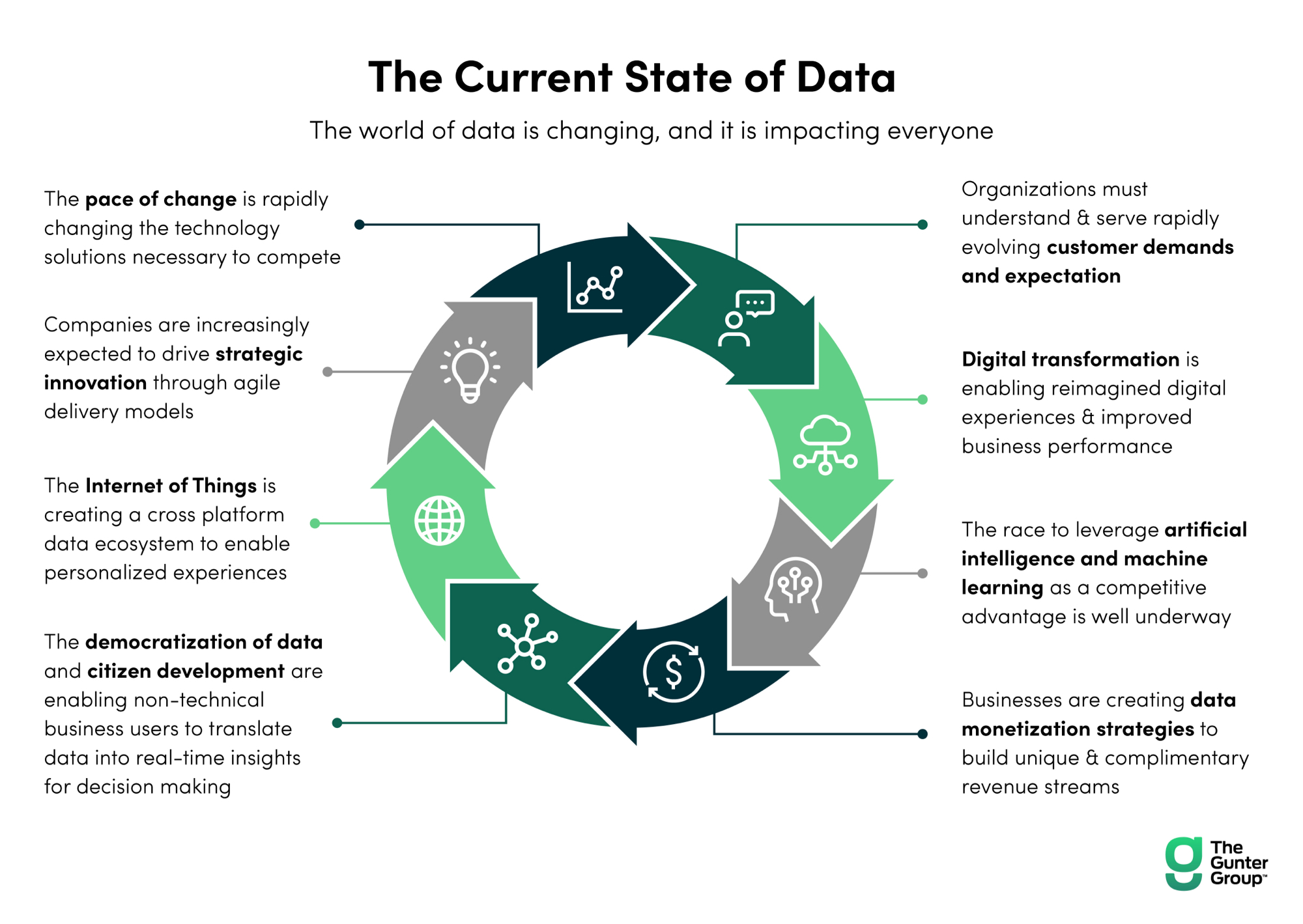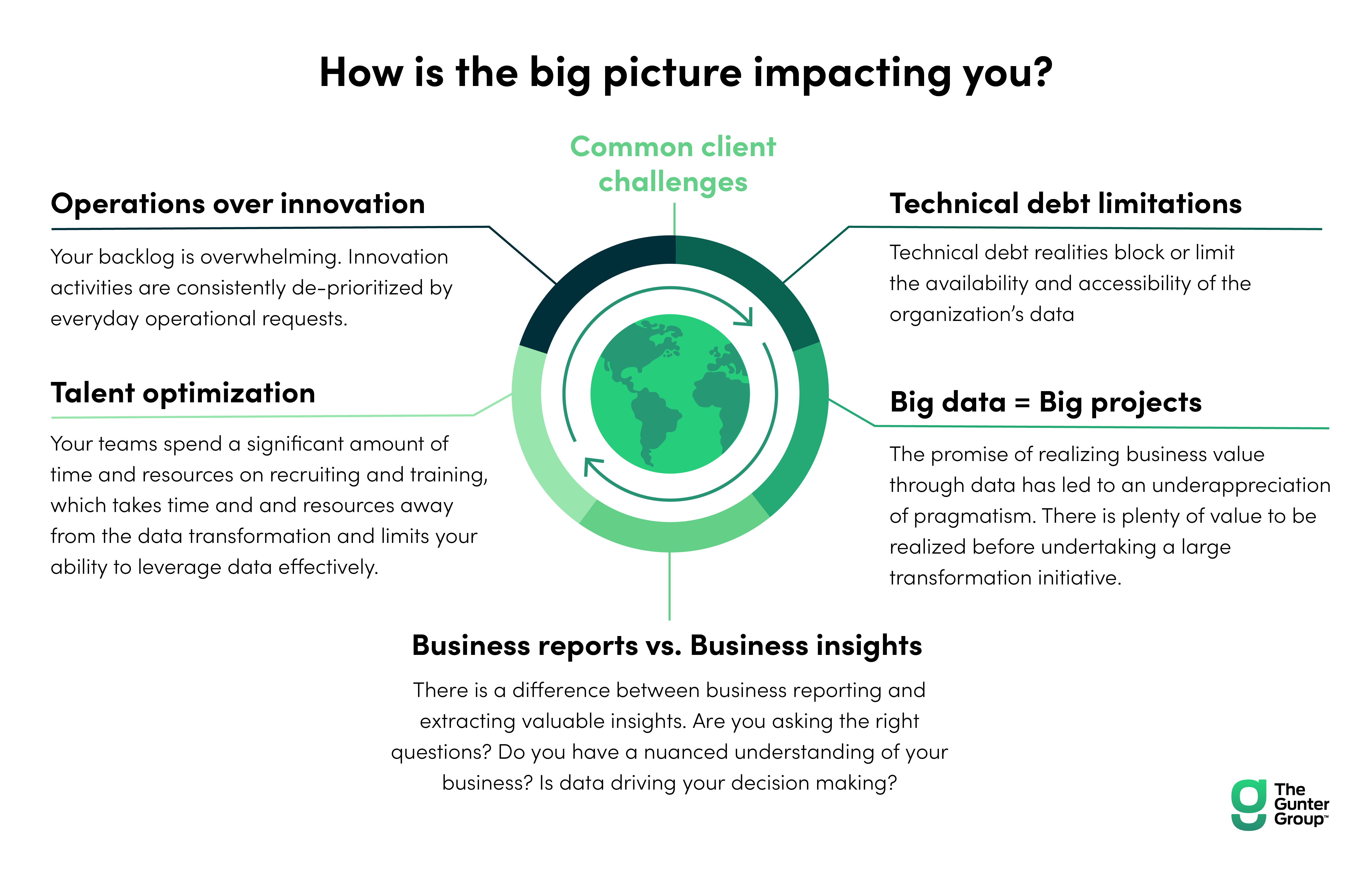SURVEYING THE DATA LANDSCAPE IN 2022

In the past, data wasn’t necessarily important to every person within a company. It was used primarily by analysts, accountants, and other specialists.
But in 2022, companies are learning that becoming a data-driven organization means incorporating data into every aspect of their business — from talent management to customer engagement and beyond — and continuously optimizing how they use data with new innovations and process improvements.
What does being data-driven look like in action? Here’s an example: a west coast retail automotive company employing over 7,000 people across 9 states came to us with the goal of implementing a mixture of data science and machine learning to identify, implement, and improve safety, employee satisfaction, customer satisfaction, and profit margin. The client asked us to work with multiple teams within manufacturing, HR, marketing, and technology innovation to build out the desired capability.
To help this company reach their goals, we provided high-level strategic insight for new initiatives, built out proof of concepts, made recommendations for innovative methodologies, designed machine learning algorithms, helped them redefine company-wide KPIs, and trained their staff on new processes.
As a result, executives are better able to make key strategic decisions and further company goals based on data-driven insights, and the entire organization’s data literacy has improved.
A shifting mindset
A few years ago, the goal for many companies was “fixing” their data processes (a reactive way of looking at data management), with a focus that was often confined to specific departments. In 2022, most organizations are approaching data management differently. They’re aiming to be far more proactive — and to stay competitive, they have to be.
It’s less about simply “cleaning up” messy data, and more about creating meaningful, long-lasting, company-wide change that will continue to drive value and inform decision making in the future. In other words, it’s all about becoming data driven across the board.
Here’s an infographic that breaks down this change in mindset and some common challenges that are forcing companies to rethink the way they approach data:


Approaching data reactively and in silos is a way of the past. To keep up with the intense pace of change, constant innovation, and evolving customer expectations in 2022, a proactive, holistic, organization-wide strategy is required.
This change is positive on multiple levels. It’s not just good for staying competitive — it’s also a way to ensure that each of the common challenges described above (talent optimization, business insights, technical debt, etc.) get addressed so you can reap the benefits of becoming a data-driven organization.
That said, embarking on a large data transformation project can sometimes feel impossible, especially if you can’t promise ROI until months (or years) down the road. At The Gunter Group, we believe in taking a different, more iterative approach that enables organizations to realize immediate value while still keeping their larger goals — and the overall data landscape — in mind.
Ready to reframe the way your organization thinks about data? Talk to the experts at The Gunter Group.
What is tech debt?
Technical debt is often defined as the cost incurred when you repeatedly choose short-term solutions rather than doing the (larger, more expensive) work of tackling the big-picture causes of your problems.
But let’s look at the issue through a different lens: what is the nature of technical debt?
Because new solutions are built and deployed every day, all organizations incur tech debt, to some degree, with every system and process implementation decision they make. Even if you implement a new, innovative solution today, there will be a better one available tomorrow. In this scenario, you will still incur tech debt — just less than an organization that makes no updates.
Too many organizations think of tech debt as a problem that can be permanently solved. In reality, it’s a constant that’s renewed continuously by change and growth, and trying to “solve” it completely is a futile pursuit.
While you can’t make tech debt vanish into thin air, you can certainly make it more manageable. If you focus on managing its impacts in an ongoing way, you can deflate its looming, monstrous reputation and get to work on making meaningful improvements in the here and now.
Is tech debt destroying your data-driven dreams?
Analytics bottlenecks are a common issue related to tech debt. Silos slow down the analytics process; if only one person knows where a spreadsheet is and how to extract meaningful data from it, they become the bottleneck.
With each short-term fix and siloed process, data becomes harder to manage, access, and analyze. In turn, drawing insights from that data requires more time and effort, the insights become less timely and less reliable, and informed decision making becomes more challenging.
In other words, tech debt has a way of draining value from data — and the longer you let that debt accrue, the more value you’re losing. Using a prioritized approach to managing tech debt can help you cover more ground right out of the gate, so you don’t lose any more value than you have to.
One way to apply this prioritized approach is with backlog grooming, the periodic process of reviewing and prioritizing backlog tasks (and removing unnecessary or outdated tasks).
How do you prioritize what areas to address?
There is a lot of information available on how to tackle tech debt. Unfortunately, most of it is theoretical. While the abstract stuff can be valuable, if you’re looking for a practical way forward, you need to bring your considerations back down to earth and fold in the business perspective to create a technical debt prioritization plan.
You probably have a lot of tools at your disposal, internally and externally, and resources to leverage. Take a look at what you need to have happen — not theoretically (e.g. eliminating all technical debt by some point in the future) — but actually.
For example, The Gunter Group recently worked with a retail automotive company that was struggling with data debt. It was impacting every area of their business, including employee satisfaction, customer satisfaction, and profit margin. They needed a new approach, but with such a vast problem, it was difficult for them to know where to start.
We worked with multiple teams within the company, including manufacturing, HR, marketing, and technology innovation to create a prioritization plan. High priority initiatives included redefining company-wide KPIs, designing and implementing machine learning algorithms, and improving data literacy across departments.
Though they still have a long way to go on their data maturity journey, this company was able to start making changes where it mattered most, rather than remaining paralyzed by the challenge ahead.
How we work with clients to tackle tech debt
Remediating data-related tech debt requires far more than just technical skills — it requires asking the right questions, gaining a holistic understanding of your organization’s business goals (as well as how they may vary across different departments), and creating a dialogue to explore possible solutions.
Each of these components requires a tremendous amount of time, which internal teams rarely have. In most cases, managing ongoing operational struggles takes priority over transformation, and team members don’t have the capacity to focus all their energy on addressing tech debt. Meanwhile, recruiting new team members is a time-consuming, resource-intensive process, and thanks to the tech talent shortage, it’s more challenging than ever.
Turning to outside help can get the data transformation ball rolling without overwhelming internal teams or opening a can of recruitment worms.
At The Gunter Group, we leverage a multidisciplinary approach (technology, people, strategy, and execution) that enables us to see the long-term big picture while solving the highest-priority problems in the short term.
Combined with our extensive technical capabilities, this approach allows our clients to chip away at their technical debt and reclaim the value of their data as quickly as possible — without the burden of hiring a new team.
Conclusion
Think about a meaningful, specific problem you’re facing right now that’s rooted in technical debt, and what you would be able to accomplish if this problem was being managed proactively.
If you set your sights on eliminating tech debt across your entire organization, you’ll likely get caught up in a complex tangle of issues — and that one major problem that’s holding you back now will still be holding you back in six months.
To accelerate your progress, identify your most pressing issues, and reach out to expert help if you need it. With the right strategy and the right partner, you can mitigate tech debt and use your data to its fullest potential.
Is technical debt slowing you down? Discover how to improve your data infrastructure and decision making with workshops hosted by The Gunter Group.
